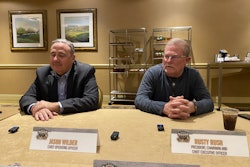It’s not every day that one finds herself riding in a truck loaded with plastic pellets destined for a Whirlpool factory in Arkansas. And it’s probably only once in a lifetime when one finds herself in this situation while the driver proves the effectiveness of a collision avoidance system by intentionally engaging in some serious tailgating.
For me, this day began on an innocent-seeming spring morning near Joliet, Ill.
I enjoy the testing process, so I was an enthusiastic participant. However, my appreciation for adventure became less a thrill and more a series of heart palpitations when the driver glanced at me over his shoulder and said with glee and a glimmer in his eye, “Here we go!” before moving within what seemed like a finger’s width of a pickup truck. System lights on the dashboard went from green, to yellow and then to an urgent red. I winced, but we quickly decelerated in a controlled manner and resumed a safe following distance.
“See? It works great!” the driver declared, laughing. I nodded and slowly released my white-knuckled grip on the door handle. I’d been ready to jump truck.
Before I get anyone into trouble, I’ll say that this was a controlled experiment. The operator behind the wheel was Ralph Bissey, who is an experienced, safe driver with Hoffman Transportation in Channahon, Ill., a company that itself is frequently recognized for its commitment to safety. Another participant who was aware that the large truck creeping up in his rearview mirror would, indeed, stop short of his bumper, was driving the pickup truck in front of us.
Our experiment wasn’t testing driver reaction time, either, but Eaton’s Next Generation VS-400 VORAD safety system. The system, which gives customers the ability to select and purchase any combination of safety-related VORAD offerings, is said to act as an invisible shield, detecting safety threats on the road often before the driver realizes his safety is compromised.
System offerings include a standard collision warning system with forward-looking radar that alerts drivers to objects up to 500 feet ahead, the BlindSpotter side sensor that provides a 120 degree field of view to identify objects alongside a vehicle and SmartCruise adaptive cruise control that automatically reduces vehicle speed to help prevent collisions.
Before our little “experiment,” we sat down with VORAD system representatives, Bissey and other Hoffman Transportation staff members to talk about their experiences implementing the safety system. Hoffman Transportation first installed the systems in 2003, “just to see how they felt.” By all accounts, it is a different feeling to drive with VORAD, because a driver has to learn to trust the system and relinquish some control, but drivers get accustomed to it quickly with a little training and the breaking of old driving habits.
“It teaches you to maintain a safe following distance,” says Bissey, who himself was once a skeptic, “You get used to it.” Bissey makes many trips between Channahon and Arkansas, driving heavy loads of plastic. VORAD gives him a greater sense of security and removes some job stress.
Eaton also now offers a Fleet Resource Manager, which allows VORAD users to record, extract and analyze safety data, including driver behavior. Reports from this system can help fleets make operational decisions to increase safety and improve fuel economy.
It’s difficult to put a price tag on something that doesn’t happen, but for Hoffman Transportation and other companies, the price of avoiding even one accident is well worth the cost to install these systems. Hoffman Transportation calls VORAD a pact they have with the public to protect safety on the roads. And while there’s no guarantee that it will lower rates, many insurance companies also look favorably on systems like these when underwriting customers’ businesses. VORAD and similar systems aren’t just beneficial for large fleets.
After my initial scare on the road, I got used to the way VORAD slowed the truck to maintain a safe following distance and it won my trust. I could see how the system would give drivers and managers greater peace of mind, another thing on which it’s hard to attach a price. At the end of the road test, Bissey shook my hand, laughed again, and told me to come back when I wanted him to show me how well his roll-stability system worked. I told him that from now on, I’d probably just take his word for it.
Distractions & Unseen Threats
Consider the following statistics when deciding whether or not to recommend a collision avoidance safety system for customer trucks. These systems help negate some critical human error.
- A National Highway Traffic Safety Administration (NHTSA) study from 1996 shows that 93 percent of all accidents involve driver error. The same study says that 54 percent of accidents are caused by driver inattention.
- According to a NHTSA study from 2003, in 36 percent of the accidents caused by changing lanes, drivers admit to being distracted.
- Approximately 15 percent of all two-vehicle lane change accidents involve large trucks. Forty-two percent of all lane change accidents occurred when large trucks merged and hit another vehicle.








